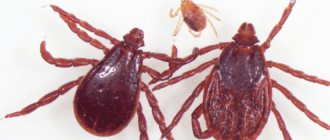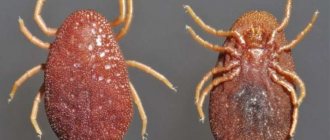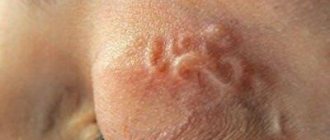With the onset of the warm season, the number of diseases caused by tick bites in cats increases sharply. With the onset of spring, pet owners begin to worry about how to protect their pet from this problem by any means. A tick bite in itself is not so terrible for a cat; dangerous pathogens are contained in the tick’s saliva, which can cause a number of dangerous and sometimes fatal diseases for a cat. Cats that walk through tall grass or dense bushes are especially at risk, where they are especially likely to pick up ticks. The tick that has just attached itself to the cat's skin is about the size of a pinhead. Over time, after he drinks blood, he grows to the size of a bean and is impossible not to notice.
General information about ticks. Ticks (Acarina) are small (0.1-30 mm) arthropods of the arachnid class (Arachnoidea) belonging to the largest group in the arthropod subclass, their number reaches 50 thousand species, most of which do not cause any harm to humans and animals. Ticks that parasitize cats are usually classified as carnivorous parasites, leading to the development of allergies, dermatitis, bacterial and viral diseases. Some ticks that attack cats drink blood, others chew the skin, and others feed on skin secretions and lymph. Cats are most often parasitized by three types of ticks:
Ixodidae (Ixodidae) are the largest ticks, which in a hungry state reach 2-3 mm in length, and after sucking blood - up to 1-1.5 cm. Scabies (internal, ear).
Subcutaneous (demodectic).
Mouth organs (piercing, gnawing, cutting, sucking). In all ticks they are formed by the first two pairs of limbs, chelicerae and pedipalgi; in ixodid ticks they consist of a pair of cutting chelicerae and a hypostome (an outgrowth of the lower edge of the mouth opening, covered with spines), tracheal or cutaneous respiration. Eyes are usually absent, less often there are 1-2 pairs. The stomach is saccular, in blood-sucking ticks with blind outgrowths that fill with blood during blood sucking. The excretory organs are represented by a pair of Malpighian vessels. Blood-sucking ticks have well-developed salivary glands, the secretion of which prevents blood clotting. All ticks are dioecious. The difference between females and males is well expressed, fertilization is internal. Most ticks are oviparous. The six-legged larva is the most characteristic feature of ticks.
The life of a tick can be roughly divided into four stages: egg, larva, nymph and adult. The total lifespan of a tick is about two months. After the tick drinks blood, it falls off and the larva begins to molt. Subsequently, the larva moves to the next stage of development, becoming a nymph; the nymph molts, turning into an adult tick, which is capable of leaving behind offspring. Ticks reproduce thanks to the female's ability to lay eggs. Considering that ticks that attack a cat multiply quickly and create optimal conditions for the development of bacteria and viruses, the owner should not delay treating the cat for ticks.
The process of a tick attacking a cat . Hungry ticks find their prey thanks to the presence of special thermal sensors. A cat passing by a bush or grass on which a tick is sitting becomes an object of attack; the tick makes a jump and, clinging to the hair, remains on the cat. Having latched onto a cat, the tick begins to look for a place on the body that is least covered with hair (skin around the ears, neck, legs, abdominal area, etc.). Further digging into the skin with its tentacles, the tick pierces the skin and begins the process of sucking blood. It becomes almost impossible to tear it away from the cat at this time, and only after the tick has completely drunk blood does it fall off the cat’s skin.
Ways a cat can become infected with ticks
Ticks that attack a cat live on the ground and in the grass, as well as on wild and domestic animals, so a cat can “catch” a tick in various ways:
- while walking on the street, in a park or forest;
- when communicating with a sick animal;
- through contaminated objects: dishes, rugs, etc.;
- from its own owner, who can bring a tick into the house on his clothes.
Even indoor cats that have never been outside can become infected with such parasites. Signs of a tick in a cat are manifested in changes in its behavior and general health, so the owner should periodically examine his pet for the presence of parasites in the fur, ears and other parts of the body.
What complications are possible?
It should be understood that diseases caused by infection with subcutaneous mites cannot go away on their own. In order to prevent dangerous complications, it is necessary to pay more attention to the pet’s behavior and its general condition, and at the first symptoms, immediately contact the clinic.
Let's look at some possible complications:
- The healthy microflora of the body will be replaced by pathogenic ones.
- Formation of diseased hair follicles.
- Processes of chronic necrosis may develop.
- In advanced cases, tick infection can cause severe intoxication in the pet's body.
- The animal itself will appear vague and severely emaciated.
To prevent infection and possible complications, you should carefully monitor your pet’s hygiene and arrange visits to the veterinarian more often.
Why are ticks dangerous for cats?
Cat ticks can be sources of a number of infectious diseases, such as infectious anemia (hemabartonellosis), Lyme disease (borreliosis), piroplasmosis, theileriosis, etc.
The culprits of the diseases are protozoan parasites that destroy red blood cells, bone marrow, lymph nodes and internal organs of the cat. The diseases are difficult to diagnose, which is why their treatment is delayed. The diagnosis of the disease is made in a veterinary clinic, examining a sample of cat blood in the laboratory .
Diagnosis of the disease
The speed of recovery depends on how quickly the diagnosis is made and how soon treatment is started. To do this, you need to go to a veterinary clinic, where they will conduct an external examination of the cat or cat, and take a skin scraping for microscopic analysis. To confirm the diagnosis, it is repeated several times. Based on the results of the study, we can draw a conclusion about the cause of the problem. A laboratory test is mandatory, since scabies mites can easily be confused with an allergic reaction, dermatitis, eczema and lichen.
The duration and intensity of treatment depends on the severity of the disease, the degree of damage and the condition of the cat at the time of examination. On average, therapy lasts from one to four weeks.
Symptoms of a tick bite
Symptoms of a tick bite in a cat may not appear immediately, but only after 2-3 weeks. Therefore, after a tick has been removed from a cat, cat owners should monitor its well-being for a given period. What should alert you:
- Refusal of the cat from the offered food, emaciation.
- Increased body temperature.
- The cat becomes lethargic and apathetic.
- Diarrhea (diarrhea in cats) and vomiting (vomiting in cats) appears, which causes dehydration in the cat.
- Shortness of breath, cough (cough in a cat).
- Anemia (anemia in cats).
- Blood in the urine (blood in the urine of a cat).
- Yellowness of visible mucous membranes (jaundice).
Folk remedies
It is recommended to use in cases where it is not possible to purchase a special drug. Folk remedies are not highly effective; they dry out the skin and cause allergies.
- Lather the cat with soap containing birch tar. Wrap it in cling film, and after 5-10 minutes bathe the animal. Repeat the procedure several times with a break of 2-3 days.
- Areas of skin with fallen hair are lubricated with kerosene. After 3 days the pet is bathed. If necessary, repeat the treatment again.
- To speed up the restoration of the epidermis, use calendula tincture and chamomile decoction. Wipe 2-3 times a day.
If there is no therapeutic effect within 7 days, you need to show the cat to a veterinarian. If an allergy appears against the background of alternative treatment, stop treatment immediately.
Diseases of cats caused by subcutaneous mites
Notoedrosis (pruritic scabies) – Notoedrosis is a chronic invasive disease of cats, clinically accompanied by dermatitis in the scalp, itching, scratching and hair loss.
Etiology. The causative agent of Notoedrosis in cats is the sarcoptic mite Notoedrosis cati. Its morphology is somewhat similar to mites of the genus Sarcoptes. The body of sexually mature ticks is round in shape and dirty gray in color. It has a body length of 0.14-0.45 mm. The proboscis is horseshoe-shaped, the anus is located on the dorsal side, and in females there is also a copulatory opening. The legs of the tick are short, thick, and cone-shaped. Male ticks have bell-shaped suckers on conical rods (ambulacras) on the 4th pair of legs. In females, the 3rd and 4th pair of legs do not have bell-shaped suckers. Itches parasitize and multiply in passages that they gnaw in the deep parts of the stratum corneum of the skin, directly bordering the malpighian layer.
Developmental biology, epizootological data, pathogenesis, clinical picture, diagnosis, differential diagnosis, treatment and prevention are described in our article - Notoedrosis (pruritic scabies) in cats.
Feline demodicosis is a chronic parasitic skin disease in cats caused by the microscopic worm-like mite Demodex cati.
Etiology. The causative agent of demodicosis, being itself an endoparasite, is localized in the hair follicles and sebaceous glands. It is half a millimeter long and has a transparent body with poorly defined boundaries between the cephalothorax and abdomen. It has short legs with hooks at the ends. The oral apparatus is equipped with a gnawing type proboscis. When a cat is infected with demodicosis, the parasite first penetrates the skin. At the site where the tick gnaws through the skin, it leaves a pronounced concentric spot. Having penetrated the skin, mites begin to feed on skin cells, and the mites multiply intensively. For more information about demodicosis in cats, see our article – Demodicosis in cats.
Otodectosis or ear scabies is a chronic invasive disease of cats caused by parasitic otodectosis mites on the inner surface of the ears and in the external auditory canal.
For more information about the disease, see our article – Otodectosis in cats.
How long does it take to treat scabies in kittens and adult cats?
Scabies can only be treated comprehensively. Depending on the severity, the doctor may prescribe, in addition to special ointments and lotions, intramuscular administration of antibiotics and antiparasitic agents. The course of treatment lasts from one to three weeks.
Most often, sulfur ointment or amitrazine is used for external use, and injections for scabies are given subcutaneously with Ivermec. The medicine destroys adult ticks and tick larvae; it is recommended for both kittens and adult cats. The injection is given intramuscularly, in the back thigh. Insulin syringes are used for injections against scabies in cats. Experts recommend the minimum dosage of the drug – 0.2 ml per 10 kg of animal weight. If the pathology is mild, one injection is enough. For more severe damage, the injection is repeated after 10 days. Ivermek is also available in the form of a spray, which is safe and convenient to use:
- Damaged areas are cleaned of scales and crusts.
- Spray Ivermec onto the fur, covering diseased and healthy skin.
- Place a collar on the cat to prevent licking of the product.
As analogues, you can use the drugs Ivomec, Ivermin, Ivervexan, Ivermikol. Using them significantly reduces treatment time, but you need to remember the possible side effects:
- nausea;
- tearfulness;
- vomiting;
- increased salivation;
- muscle tremors.
Sarcoptic mange in cats
Sarcoptic mange (pruritic mange) is a disease of cats caused by pruritic mites of the genus Sarcoptes.
Most often in cats, the muzzle, wings of the nose, forehead are affected, and then the whole body is affected. Mites living deep in the skin cause severe itching. Cats affected by sarcoptic mange cannot sleep and eat peacefully; they quickly experience nervous and physical exhaustion. Cats affected by sarcoptic mange can be easily identified by unpleasant-looking scabs, scabs and large bald patches.
The primary symptoms of the disease are similar to food allergies (food allergies in animals), localized on the face, quickly affecting the entire body, the cat’s body becomes almost naked, the entire skin is covered with scabs, in place of the fallen scabs, erosions and ulcers form in the cat, and unbearable itching is observed . The disease is not contagious to humans, but can cause a short-term allergic reaction.
Injured skin is highly susceptible to bacterial and fungal infections, and blood poisoning can also occur. Therefore, without timely help, a heavily infected animal dies.
Diagnosis . The diagnosis of sarcoptic mange by veterinarians is made based on the symptoms of the disease and microscopy of mites in an in-depth skin scraping.
Differential diagnosis . Sarcoptic mange is differentiated from demodicosis and otodectosis.
Treatment. Treatment of a cat with sarcoptic mange begins with cleaning the affected area in order to apply medications. When cutting off affected areas, it is important not to miss a single area of inflammation, otherwise it will become a source of new spread of the tick. Before applying external medications, it is necessary to soften the crusts with shampoo, a solution of furacillin or perhydrol.
The following drugs are used to treat mites with sarcoptic mange: demos, amitrazine, amitforte, ivermec - gel, drops on the withers.
When applying drops to the withers area, which have a long-term acaricidal effect (up to a month), we additionally act on helminths (worms in cats), fleas (fleas in cats), lice, lice. The following are used as acaricidal preparations for application to the cat's withers: Strongyl, Dironet, Alvocat, helminthal K, IN-AP complex.
In cases where sarcoptic mange in a cat is advanced and there is a complication of secondary microflora, the following medications are additionally used: antimicrobials, antimycotics, immunostimulants.
Risk factors
The stronger the cat’s immunity, the greater the likelihood that he will cope with the parasite on his own, because not all animals that come into contact with scabies mites get sick. There are several factors that can increase your risk of infection. These include:
- damage to the skin (wounds, scratches, ulcers);
- close contact with sick cats, cats and other animals;
- weakened immunity due to recent surgery, treatment with antibiotics or hormonal drugs;
- the presence of helminths or external parasites (fleas, ticks, lice);
- unbalanced, insufficient calorie diet;
- age younger than two years or older than eight.
It should be noted that British and Siamese cats and male cats are slightly more likely to develop mange than other breeds. This is explained by the individual characteristics of their body.
Tick-borne encephalitis in a cat
With tick-borne encephalitis, the virus that enters the bloodstream during a tick bite travels through the bloodstream to the brain. Inflammation of the gray matter of the brain occurs, swelling of the cerebral cortex develops and the cat dies from complications, including paralysis, loss of vision and epilepsy.
Carriers of encephalitis
The carrier of encephalitis is most often Ixodes Persulcatus (taiga tick), which inhabits the Asian and some European regions of Russia, as well as Ixodes Ricinus (European forest tick), which has chosen its European territories.
In addition, representatives of the family Haemaphysalis are also capable of transmitting encephalitis . These ticks live in the deciduous forests of Transcaucasia, Crimea and the Far East. The threat of infection with encephalitis, tularemia and Omsk hemorrhagic fever also comes from ticks of the genus Dermacentor.
Clinical picture of the disease
The acute form of the disease is observed in cats with reduced immunity several hours after the bite. Over the course of a day, the disease worsens: the cat becomes febrile and unsteady, it does not respond to food and water, diarrhea and profuse salivation begin, the mucous membranes turn pale, and muscle pain appears. It all ends with convulsions, paralysis and falling into a coma.
In cats with stronger immunity, the disease drags on for 2 weeks, manifesting itself in the incubation phase with weakness, a slight (2-3°) increase in temperature, discharge from the nose and eyes, and refusal to eat. After 9-14 days, a malfunction occurs in the central nervous system: convulsions and paralysis are noted, the animal loses consciousness or falls into a lethargic state.
Treatment. In the acute course of the disease, replacement therapy, corticosteroids and intravenous injections are indicated. Along with this, the cat receives immunostimulants, vitamins, antihistamines, antipyretics, painkillers and absorbents.
If encephalitis has transformed into chronic meningitis, complications cannot be avoided, and treatment of the pet will take more than one month.
Prevention
Preventing ticks from infesting cats by preventing contact with their relatives is almost impossible. The only way out is to prevent tick attacks on cats by using flea collars, drops and water-soluble emulsions.
If there are unfavorable areas for ticks in your area, they should be avoided. Before letting your cat into your apartment, you need to thoroughly comb out the fur with a fine comb and inspect the belly, paws, chest and ears for ticks.
Given that mites have the ability to survive for some time outside the cat's body, owners must protect their animals from re-infestation.
It is better to burn low-value items in the apartment, treat the floors with an acaricidal spray and wash them thoroughly.
Regular deworming, vaccination, disinfestation, and adequate feeding will provide the cat with strong immunity, which will not allow ticks that have fallen on the cat to actively reproduce.











